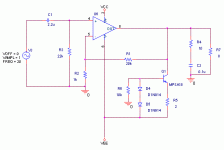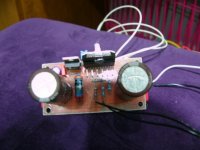mikelm said:
I like to try and get the best out of budget gear and these speakers have really responded. My next plans are to clad the sides with marble and extend the cabinet at the back in a tapering shape.
Mike, those are excellent speakers, they are only very hard to drive.
The 600 and 601 S3 are much easier.
I don't know if there's a difference on the crossover, or if it's just the enclosure/bass reflex construction.
Anyway, you are on the right path for sure, as those speakers sound much more than they cost.
neutron7 said:...the actual amount of dc ofset is up to you you could have :
first watt
first 5 watts
1/2 psu volt do its all class a but only same power as 1 chip
mikelm said:...I do not see how your sceme works at present; what is the path for thr extra bias current ?
You're right mikelm, this does not work at all.
Neutron7, dc voltage offset doesn't move a class AB amplifier more into class A, as long as no offset current is introduced. Offset current is what matters.
Steven
Class A amps often having a more natural sound, intruments sound more real.
biasing an AB amp a little more into class A means that the first watt or so is operating in class A. This means that you have to play it louder before one or other of the o/p transistors begins switching off with every half cycle.
This means the switching noise take place against a louder volume of music which means that it is has less impact. In other words the signal to (switching) noise ratio is improved.
For a subjective review on the chip amp we are waiting ( patiently ) for Carlos to deliver his verdict ( and as Julia Roberts says there is always a pause when the jury goes out to consider it's verdict )
) for Carlos to deliver his verdict ( and as Julia Roberts says there is always a pause when the jury goes out to consider it's verdict )
However this technique is well known to be benificial for regular op amps.
Of course there will varying opinions so I am not expecting a unanimous verdict in the long run...
mike
biasing an AB amp a little more into class A means that the first watt or so is operating in class A. This means that you have to play it louder before one or other of the o/p transistors begins switching off with every half cycle.
This means the switching noise take place against a louder volume of music which means that it is has less impact. In other words the signal to (switching) noise ratio is improved.
For a subjective review on the chip amp we are waiting ( patiently
However this technique is well known to be benificial for regular op amps.
Of course there will varying opinions so I am not expecting a unanimous verdict in the long run...
mike
Another reason was posed by Bruno Putzeys in the UCD180 questions thread (CLass D), quoting:
"(on biasing op amps)
I've seen quite a number of discussions on biasing op amps in class A. The ones I've seen were all wrong in their interpretation of what's happening and what they're trying to achieve.
Here's how it should go:
A current source is tied between output and the rail where the miller VAS is located. This rail can be recognised from the data sheet because it´s got 20dB worse PSRR than the other one.
By biasing the output transistor off, this current source will insure that this rail sees only a constant DC load, thus removing signal-related content from it.
From this you can see that it's not about class A, but about power supply effects. Some people think they can get round by using a resistor instead of a proper current source. Wrong, because the power supply will be affected same as if that resistor was just the load to ground. Only a proper current source will do, and if it's tied to the wrong rail - no cigar either."
Steven
"(on biasing op amps)
I've seen quite a number of discussions on biasing op amps in class A. The ones I've seen were all wrong in their interpretation of what's happening and what they're trying to achieve.
Here's how it should go:
A current source is tied between output and the rail where the miller VAS is located. This rail can be recognised from the data sheet because it´s got 20dB worse PSRR than the other one.
By biasing the output transistor off, this current source will insure that this rail sees only a constant DC load, thus removing signal-related content from it.
From this you can see that it's not about class A, but about power supply effects. Some people think they can get round by using a resistor instead of a proper current source. Wrong, because the power supply will be affected same as if that resistor was just the load to ground. Only a proper current source will do, and if it's tied to the wrong rail - no cigar either."
Steven
Mike, I'm testing on my main system, where I can't be fooled.
I'm using 120 ohm resistors, exacly as I posted here:
http://www.diyaudio.com/forums/showthread.php?postid=507119#post507119
Initial impressions with test speakers confirm, the sound seams to get smoother, and smooths even more the more bias I use.
This is not what I call a direct connection to the music, it robs it's directness, it's detail, it's immediacy, the natural timbre and harmonics of the instruments, it's similarity to a live performance.
Curiously, some people like it this way...
As a conclusion, at least with the simple resistor method, no go.
I'm using 120 ohm resistors, exacly as I posted here:
http://www.diyaudio.com/forums/showthread.php?postid=507119#post507119
Initial impressions with test speakers confirm, the sound seams to get smoother, and smooths even more the more bias I use.
This is not what I call a direct connection to the music, it robs it's directness, it's detail, it's immediacy, the natural timbre and harmonics of the instruments, it's similarity to a live performance.
Curiously, some people like it this way...

As a conclusion, at least with the simple resistor method, no go.
Have you made it yet , or just simulated ?
400mA should be OK but you must keep every thing cool enough
If you have enough heat sink, you could try 100mA, 200mA and 400mA to see which you prefer. It will very easy to make the current variable.
For very best results you may need a seperate quiet regulated supply to sink the current.
mike
400mA should be OK but you must keep every thing cool enough
If you have enough heat sink, you could try 100mA, 200mA and 400mA to see which you prefer. It will very easy to make the current variable.
For very best results you may need a seperate quiet regulated supply to sink the current.
mike
gengcard said:Could you suggest me which transistor should be instead of MPSA18?
2n3055.
You can find them everywhere, and they are cheap.
2n3055.
Thank you Carlos for your advice. I'll find it one.
LM3875 Class A
How about using LM337 as a CCS to bias 0.5A to 1.5A current.
In this case the resistor wattage could be only 1 - 2 Watt.
This could also be replaced with LM317 or LT1085 with few adjustments.
This one has been tested with around 0.5A bias current with hours of music with no significant dc offset changes from normal operation mode. It comes with switch between class AB and A for quick comparision listening test.
http://www.htg2.net/index.php?topic=20586
I can confirm that it changed how LM3875 in normal operation sound. With low volume, few mins of burning in, not so complex music, it is more obvious, I was stunned. The sound is more smooth, more focus, more depth in soundstage but some how narrower. The sound is more like real performance to me which I like but I also notice that the details is some how dropped which I tried to improve. (I'm a newbie in electronics by the way.)
One thing I suspect is the capacitor used in CCS part. this might damp the sound so the detail is not good. I would try to take them off and do the listening test again.
Every comments on how to improve this impliment are at most welcome as this one is just a conceptual study on biasing power chip amp into class A.
How about using LM337 as a CCS to bias 0.5A to 1.5A current.
In this case the resistor wattage could be only 1 - 2 Watt.
This could also be replaced with LM317 or LT1085 with few adjustments.
This one has been tested with around 0.5A bias current with hours of music with no significant dc offset changes from normal operation mode. It comes with switch between class AB and A for quick comparision listening test.
http://www.htg2.net/index.php?topic=20586
I can confirm that it changed how LM3875 in normal operation sound. With low volume, few mins of burning in, not so complex music, it is more obvious, I was stunned. The sound is more smooth, more focus, more depth in soundstage but some how narrower. The sound is more like real performance to me which I like but I also notice that the details is some how dropped which I tried to improve. (I'm a newbie in electronics by the way.)
One thing I suspect is the capacitor used in CCS part. this might damp the sound so the detail is not good. I would try to take them off and do the listening test again.

Every comments on how to improve this impliment are at most welcome as this one is just a conceptual study on biasing power chip amp into class A.
I was just reminded by someone that this thread, which I began many moons ago, existed and having just moved back from the USA after five years I found in my stored possessions in the UK the same 1/2 built amps which I referred to here so it may be I will check out this idea.
Having just re-read the thread I am not surprised that carlos's resistor biased amps lost their "live", dynamic sound, the amps o/p circuits would have to have to work to switch the current to drive those resistors. The active current sources should be "invisible" to the signal so I would expect the circuit implemented this way to sound different and hopefully more effortless & dynamic.
Of course after the 1st watt or so the amps will go into AB but 1 watt is quite loud so any switching noise should be virtually imperceptible.
mike
Having just re-read the thread I am not surprised that carlos's resistor biased amps lost their "live", dynamic sound, the amps o/p circuits would have to have to work to switch the current to drive those resistors. The active current sources should be "invisible" to the signal so I would expect the circuit implemented this way to sound different and hopefully more effortless & dynamic.
Of course after the 1st watt or so the amps will go into AB but 1 watt is quite loud so any switching noise should be virtually imperceptible.
mike
Last edited:
- Status
- This old topic is closed. If you want to reopen this topic, contact a moderator using the "Report Post" button.
- Home
- Amplifiers
- Chip Amps
- First Watt balanced gainclone idea


 It's hard to choose one.
It's hard to choose one.